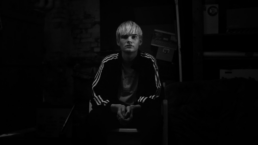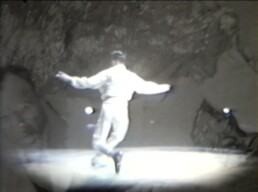FUSO 2022 – 23 a 28 de Agosto
26 Agosto, 22h00
Palácio Sinel de Cordes – Trienal de Arquitetura de Lisboa
A UTOPIA DA PAZ – FILMES DA COLEÇÃO CAM, GULBENKIAN
Benjamin Weil e Leonor Nazaré
A utopia da paz tem sido uma “ilha” que flutua, desafortunada, no mapa da história humana de todas as guerras.
Susana Gaudêncio parte das zonas habitacionais do Porto chamadas “Ilhas” para uma reflexão sobre a questão colonial, que Maria Lusitano, por sua vez, trata com humor crítico e documentação abundante no filme Nostalgia.
Em tom manifestamente mais negro, Daniel Barroca fragmenta a percepção do corpo e dos territórios da guerra até à abstracção que os dissolve, Salomé Lamas dá voz à experiência de um mercenário bastante jovem cuja profissão foi matar a comando de grupos muito corruptos e Jan Fabre filma a representação de uma luta interior, por um cavaleiro medieval que combate os seus próprios demónios.
A luta parece ser uma condição do humano, mas o objecto dos seus combates denota, quase sempre, um desvio lamentável ao que poderia ser pensado como propósito essencial da experiência da vida: a consciência ligada à autodescoberta, à compreensão do universo e à construção colectiva.
ILHAS AFORTUNADAS – Susana Gaudêncio
Ilhas Afortunadas explora a caminhada como método ancestral de viagem crítica, que catalisa o conhecimento e o acto criativo, e ainda o conceito de insularidade enquanto desejo de imaginação, utopia, autonomia ou refúgio. (…)
Em Ilhas Afortunadas, ouve-se uma narradora em voz off — a da artista, que faz uma caminhada na cidade do Porto. Como um livro de bordo, a animação-vídeo assinala pormenores do que observa, dos locais que visita, bem como inúmeras reflexões sobre as ilhas do Porto (tipologia insalubre de casa urbana), as ilhas na Europa, o mito grego das ilhas afortunadas e do 5ª Império Português (Fernando Pessoa), as ilhas utópicas, as do turismo e as dos refugiados.
LANCELOT – Jan Fabre
Resultado de uma performance filmada de quatro horas, este confronto de inspiração romanesca tem como protagonista a célebre figura de Lancelot(e), um dos cavaleiros do Rei Artur. A estrutura sonora do filme é um elemento-chave da composição, fazendo sentir o frio, o desconforto, o cansaço e o desespero. A luta aqui travada é consigo mesmo, com a sua própria sombra, ou duplo. A alegoria é representada com gritos e suor, quedas e recomeços, escuridão e restrição espacial, vontade e perda, forte fisicalidade, mas também intenso movimento interior. O guerreiro combate um inimigo invisível, dentro da sua armadura e do seu “Graal”, recriado a cinzento escuro de metal e pedra.
LE BOUDIN – Salomé Lamas
Le Boudin (nome dado à marcha da Legião Estrangeira Francesa) documenta a história de vida de Nuno Fialho, que aos 16 anos deixou Portugal para integrar a Legião Estrangeira Francesa, num pelotão constituído por fugidos à justiça, com missões obscuras e ligadas a barões da droga e homens corruptos: limpezas étnicas e deposições de presidentes em África, guerrilhas urbanas e tarefas mercenárias várias. A realizadora conduz uma entrevista a Nuno Fialho em 2011, para depois a reproduzir através da interpretação de Elias Geißler, actor alemão de 16 anos, que desta forma dá voz e corpo à narrativa de Nuno Fialho.
A tonalidade documental é enriquecida e desestabilizada pela especificidade fisionómica do rapaz, pelo cenário, pelas emoções mitigadas e pela forma como a “dúvida” sobre a veracidade dos relatos se insinua no aparente realismo do testemunho e da obra.
NOSTALGIA – Maria Lusitano
Situado entre o vídeo-ensaio, o documentário e a ficção, Nostalgia é produto de uma longa investigação que se serve de imagens de arquivo representativas do colonialismo português em Moçambique, bem como de entrevistas com portugueses nascidos em Moçambique, retornados depois da independência da antiga colónia. É produzido a partir de imagens filmadas em Super 8, postais, fotografias, telegramas e aerogramas transpostos para minDV. O narrador do filme é o irmão duma rapariga que casa e parte para África com o marido, soldado na guerra do Ultramar: um adolescente de dezasseis anos que parte também para Lourenço Marques (actual Maputo) e que descreve, numa perspectiva adolescente e encantada, um lugar fantástico e “paradisíaco”, que em muito contrasta com as duras realidades do colonialismo e da guerra. A obra problematiza o colonialismo e o pós-colonialismo.
SOLDIER PLAYING WITH A DEAD LIZARD – Daniel Barroca
Daniel Barroca trabalha apenas com filme, desenvolvendo uma pesquisa importante e consistente de caráter antropológico e artístico. Nos seus filmes recorre a um registo baseado no tratamento poético da “poeira do tempo”, na experimentação, na deficiência assumida dos registos e na procura da expressividade do médium. As imagens são desfocadas e difusas, quase sempre perto da abstração.
Soldier playing with a dead lizard faz parte de uma instalação composta por 8 filmes. Se os primeiros são uma viagem tranquila pela simplicidade lúdica de um homem que brinca com um lagarto, neste filme as armas irrompem com brutalidade. A obra foi realizada a partir de um filme de super8 que encontrou em Berlim em 2011. Trata-se de propaganda Nazi sobre a invasão de Creta. O artista desmontou o filme e a mensagem de propaganda que glorificava a violência, e reinventou o filme a partir de fragmentos muito curtos.
FUSO 2022 – August 23rd to 28th
August 26th, 10pm
Palácio Sinel de Cordes – Trienal de Arquitetura de Lisboa
THE UTOPIA OF PEACE – FILMS FROM THE CAM COLLECTION, GULBENKIAN
Benjamin Weil and Leonor Nazaré
The utopia of peace is a floating “island”, an unfortunate one, on the map of human history of all the wars.
Susana Gaudêncio starts from the observation of a specific housing typology at the city of Porto called “Ilhas” (islands), for a reflection on the colonial question, which Maria Lusitano, in turn, treats with critical humor and abundant documentation on the film “Nostalgia”.
In a manifestly darker tone, Daniel Barroca fragments the perception of the body and of the territories of war until they dissolve into abstraction. Salome Lamas gives voice to a rather young mercenary whose profession was to kill at the command of very corrupt groups, and Jan Fabre, in this film, depicts the inner struggle of a medieval knight fighting his inner demons.
Fighting seems to be the human condition, but the object of these fights is almost always a sign of a regrettable deviation from what could have been the essential purpose of the experience of life: consciousness linked to self-discovery, to the understanding of the universe and a collective construct.
FORTUNATE ISLES – Susana Gaudêncio
Ilhas Afortunadas explores the act of walking as an ancestral method of critical travel, which catalyzes knowledge and the creative act, as well as the concept of insularity as desire for imagination, utopia, autonomy or refuge. (…)
In Ilhas Afortunadas, a narrator is heard in voice off – the artist is walking about in the city of Porto. Like a logbook, the animation highlights details of what she sees, of the places visited, while her numerous reflections about the “isles” in Porto are heard(the typology of insaloubrious urban housing), on the islands in Europe, the Greek myth of the Fortunate Isles and the islands of the Fifth Empire (Fernando Pessoa). Isles for tourism and for the refugees.
LANCELOT – Jan Fabre
The result of a filmed performance of four hours, this confrontation of romanesque inspiration has as its protagonist the famous figure of Lancelot(e), one of the knights of King Arthur. The sound structure of the film is a key element of the composition, inducing feelings of cold, discomfort, tiredness and despair. Here, the struggle is with himself, with his own shadow, or his double. The allegory is represented with screams and sweat, falls and restarts, darkness and spatial restriction, will and loss, strong physicality, but also intense inner movement. The warrior fights an invisible enemy, inside his armor and his “Grail”, recreated in dark gray metal and stone.
LE BOUDIN – Salomé Lamas
Le Boudin (The name given to the French Foreign Legion) documents the life story of Nuno Fialho, who at the age of 16 leaves Portugal to join the French Foreign Legion, in a platoon made up of fugitives from justice, with obscure missions linked to drug barons and corrupt men: ethnic cleansing and deposition of presidents in Africa, urban guerrillas and various mercenary operations. Lamas conducts an interview with Nuno Fialho in 2011, and then reproduces it through the interpretation of Elias Geißler, a 16-year-old German actor, thus giving voice and body to the narrative of Nuno Fialho.The documentary tone is enriched and destabilized by the physiognomic specificity of the boy, by the scenario, by the mitigated emotions and by the way the “doubt” about the veracity of the reports is insinuated in the apparent realism of the testimony and of the work.
NOSTALGIA – Maria Lusitano
Between video-essay, documentary and fiction, “Nostalgia” is the product of a long research process that uses archival images representative of Portuguese colonialism in Mozambique, as well as interviews with portuguese people born in Mozambique, who returned [to Portugal] after the independence of the former colony. It assembles images filmed in Super 8, postcards, photographs, telegrams and aerograms transposed to minDV. The narrator in the film is the brother of a girl who marries and leaves for Africa with her husband, a soldier in the colonial war: a sixteen-year-old teenager who also leaves for Lourenço Marques (now Maputo) and describes, from an enchanted adolescent perspective, a fantastic and “paradisiac” place, which contrasts greatly with the harsh realities of colonialism and war. The work problematizes colonialism and post-colonialism.
SOLDIER PLAYING WITH A DEAD LIZARD – Daniel Barroca
Daniel Barroca works solely with film, developing an important and consistent research of anthropological and artistic nature. In his films he uses a register based on the poetic treatment of the “dust of time”, experimentation, the predictable deficiency of the records, and the search for the medium’s expressiveness. The images are blurry and diffuse, almost always close to abstraction.
Soldier playing with a dead lizard is part of an installation composed by eight films. If the other films are a quiet journey through the joyous simplicity of a man who plays with a lizard, in this film the weapons erupt with brutality. The work was made after a super8 film Barroca found in Berlin, in 2011. It is Nazi propaganda about the invasion of Crete. The artist disassembles the film and the propaganda that glorifies violence, reinventing the film from very short fragments.











